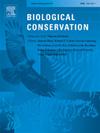Is net illumination a silver bullet for mitigating sea turtle bycatch in set net fisheries?
IF 4.9
1区 环境科学与生态学
Q1 BIODIVERSITY CONSERVATION
引用次数: 0
Abstract
Fisheries bycatch is the main threat to sea turtle populations in marine habitats in the Mediterranean Sea. Bycatch in set nets accounts for 30,000 catches yearly, which combined with mortality rates of up to 82.6 %, makes it the deadliest fishing gear in the region. The Adriatic Sea is one of the most important foraging and developmental habitats for loggerhead sea turtles (Caretta caretta) in the Mediterranean. Bycatch in the Adriatic small-scale set net fishery is estimated at over 8900 individuals per year placing its mitigation among international conservation priorities. Use of light emitting diodes (LED lights) of different wavelengths as bycatch deterrents was proposed as an effective conservation tool, reducing bycatch levels by up to 93 %. In the present study we: (i) quantified the effects of net illumination on loggerhead sea turtle bycatch rates and (ii) demonstrate the importance of regional validation of conservation tools effectiveness prior to their widespread adoption. We assessed the effects of green LED lights on sea turtle bycatch rates in 390 net pairs with total length of 1278 km monitored nets. We found no significant change in sea turtle bycatch rates as a result of net illumination. A significant decrease of 35 % of primary target catch was observed in illuminated trammel nets. Possible explanations include fluctuating turbidity and an adapted LED light attachment method. Observed sea turtle bycatch rates in unilluminated nets were up to 84 times lower than in comparable gears in Northern Adriatic Sea. Understanding the drivers behind the differing bycatch rates would be necessary before conservation decisions are made. Our study showed that the net illumination is not necessarily a silver bullet for bycatch mitigation in set nets globally, and that regional testing is a key requirement before its introduction in fisheries as a conservation tool.
求助全文
约1分钟内获得全文
求助全文
来源期刊

Biological Conservation
环境科学-环境科学
CiteScore
10.20
自引率
3.40%
发文量
295
审稿时长
61 days
期刊介绍:
Biological Conservation is an international leading journal in the discipline of conservation biology. The journal publishes articles spanning a diverse range of fields that contribute to the biological, sociological, and economic dimensions of conservation and natural resource management. The primary aim of Biological Conservation is the publication of high-quality papers that advance the science and practice of conservation, or which demonstrate the application of conservation principles for natural resource management and policy. Therefore it will be of interest to a broad international readership.
 求助内容:
求助内容: 应助结果提醒方式:
应助结果提醒方式:


